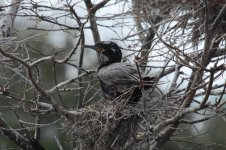1 January - Castellow Hammock Preserve/Everglades.
In traditional style, I was up way before dawn to celebrate the New Year, 4.00 a.m. to be exact. The idea had been to find some elusive mammal or perhaps an owl to kick the year off, but as it was, a Wilson's Snipe took the honours, a singleton bobbing in the car lights as it fed aside a small roadside pool.
Before getting totally lost on random farm tracks, I then veered a little to the north, ensuring a dawn arrival at Castellow Hammock Preserve. A fairly small area of protected tropical hardwood in an otherwise residential area, this locality was simply excellent. Before it was even light enough to begin proper birding, as I strolled around the lawn in front of the visitor centre, Grey Catbirds and Northern Mockingbirds were emerging from the bushes, American Robins pouncing out onto the lawn and a Blue Jay into a tree. Up came the sun, out came even more birds. A rainbow of colours in a single low tree, a most impressive warbler flock was certainly nice for the 1st January - amongst Palm Warblers and Yellow-rumped Warblers, a positive feast for the eyes with two superb Northern Parula, two stunning Black-throated Green Warblers, one Prairie Warbler and a smart Black-and-White Warbler. Also Blue-Grey Gnatcatchers with them and, in the next tree along, two Loggerhead Shrikes.
As the warbler flock eventually began to dissipate, I relocated myself all of a hundred metres or so to the a series of large flowering shrubs. With a considerable warmth already in the rising sun, I had high hopes amongst these blooms. Zip, zip, a little fleck of a bird zooming by, a brief hover, then radical change of direction and the dot hurtled away to a perch high up. Super, this was exactly what I was looking for ...hummingbirds! Not terribly abundant in winter, this locality has a good reputation for harbouring a few most years, the blossoms a magnet. And so I settled down and waited, and soon there was another, and another. Then another. Oh ho ho, almost a dozen by the end! Four months earlier I was watching Rufous Hummingbirds in southern Alaska on their summering grounds, here I was now watching their in their winter home, neat. And just for good measure, one Ruby-throated Hummingbirds too.
Also walked the woodland trail, but saw very little, so decided to return via a residential crawl to the hotel for coffee, Monk Parakeet, Common Myna and White-winged Dove amongst birds decorating gardens. Sadly, my trip to Florida was almost over, in a few hours I would be aboard the plane and heading towards Europe. Still time however for one last outing. Chucked all the bags in the boot and, to finish where it had all started, returned to the Everglades for a few hours. Alligators sunning, Red-shouldered Hawks atop bushes, a Northern Harrier quartering, all familiar birds now, but this was a most relaxing and enjoyable way to end the trip. On the Anhinga Trail, as well as all the assorted herons and egrets, added one very nice American Purple Gallinule and gazed up at the kettles of Turkey Vultures rising on the thermals.
Ah boo hoo, it was now early afternoon and time to head for Miami. Did sneak in a last detour, incorporating the edge of Biscayne National Park onto my route, adding a few Brown Pelicans atop posts. More impressive however was the adjacent rubbish tip - this was simply mind boggling, above the immense mound of trash rising a couple of hundred metres was an even more immense cloud of birds, not just gulls, but also thousands and thousands of Turkey Vultures! Wow moment indeed.
And then it really was time up, zigzagged through south Miami, saw a couple of feral Muscovy Ducks on a pool and arrived at Miami International in good time for my flight. American Airlines to Atlanta, British Airways to London, trip over.
***** The End *****
Will perhaps add a few more pictures as I finish sorting them.






